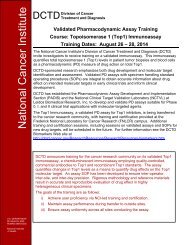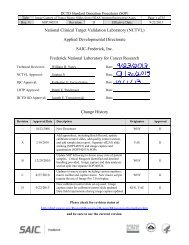National Cancer Institute - NCI Division of Cancer Treatment and ...
National Cancer Institute - NCI Division of Cancer Treatment and ...
National Cancer Institute - NCI Division of Cancer Treatment and ...
You also want an ePaper? Increase the reach of your titles
YUMPU automatically turns print PDFs into web optimized ePapers that Google loves.
pediatric phase I <strong>and</strong> pilot studies, thus<br />
facilitating the integration <strong>of</strong> advances<br />
in cancer biology <strong>and</strong> therapy into the<br />
treatment <strong>of</strong> childhood cancer. The<br />
consortium includes approximately<br />
20 institutions. Pharmacokinetic <strong>and</strong><br />
biological correlative studies are key<br />
components <strong>of</strong> the consortium’s phase<br />
I trials <strong>and</strong> are increasingly important<br />
for new agents with specific molecular<br />
targets. The consortium conducts pilot<br />
studies <strong>of</strong> promising multi-agent regimens.<br />
These studies are an important<br />
step in the integration <strong>of</strong> new agents<br />
into the therapy <strong>of</strong> specific childhood<br />
cancers <strong>and</strong> require careful monitoring<br />
for toxicity <strong>and</strong> safety. After their initial<br />
evaluation for safety in children by the<br />
consortium, agents <strong>and</strong> regimens can<br />
be studied within the larger group <strong>of</strong><br />
COG institutions to determine their role<br />
in the treatment <strong>of</strong> specific childhood<br />
cancers.<br />
■ New Approaches to Neuroblastoma<br />
Therapy (NANT) Consortium: This<br />
collaborative group brings together<br />
university <strong>and</strong> children’s hospitals to test<br />
promising new therapies <strong>and</strong> combination<br />
therapies for high-risk neuroblastoma.<br />
The group is closely linked with<br />
laboratory programs developing novel<br />
therapies for high-risk neuroblastoma.<br />
The group conducts limited clinical trials,<br />
with the goal that promising therapies<br />
will be tested nationally.<br />
■ Pediatric Brain Tumor Consortium<br />
(PBTC): This group’s primary objective is<br />
to rapidly conduct phase I <strong>and</strong> II clinical<br />
evaluations <strong>of</strong> new therapeutic drugs,<br />
intrathecal agents, delivery technologies,<br />
biological therapies, <strong>and</strong> radiation<br />
treatment strategies for children 0–21<br />
years <strong>of</strong> age with primary central nervous<br />
system tumors. The PBTC consists<br />
<strong>of</strong> nine leading academic institutions<br />
that have extensive experience with<br />
tumors <strong>of</strong> the brain that develop during<br />
childhood. Another objective <strong>of</strong> the<br />
PBTC is to develop <strong>and</strong> coordinate innovative<br />
neuroimaging techniques.<br />
■ Pediatric Preclinical Testing Program:<br />
The Pediatric Preclinical Testing Program<br />
assists clinical researchers in selecting<br />
study agents <strong>and</strong> combination therapies<br />
that are most likely to be effective for<br />
childhood solid tumors <strong>and</strong> leukemias.<br />
Some correlations have been observed<br />
between preclinical antitumor activity<br />
<strong>of</strong> agents tested in pediatric tumor<br />
models <strong>and</strong> clinical activity for these<br />
same agents. Although these examples<br />
support the potential predictive value<br />
<strong>of</strong> preclinical models, validation <strong>of</strong><br />
the models across a broader range<br />
C A N C E R T H E R A P Y E V A L U A T I O N P R O G R A M ■ 69<br />
<strong>NCI</strong> Visuals Online, Bill Branson, photographer.










